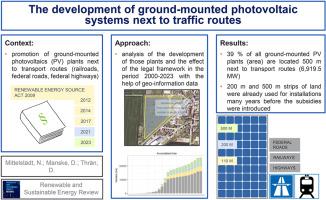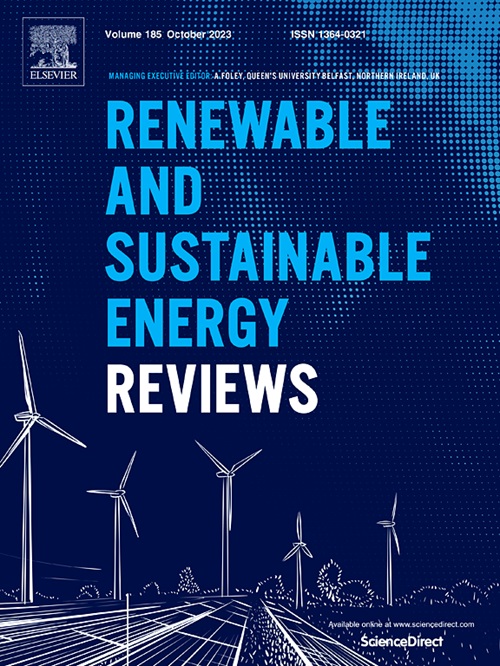The development of ground-mounted photovoltaic systems next to transport routes
IF 16.3
1区 工程技术
Q1 ENERGY & FUELS
引用次数: 0
Abstract
Since 2009, Germany's Renewable Energy Sources Act has promoted the erection of ground-mounted photovoltaic (PV) plants next to transport routes (railways, federal roads and federal highways) as these areas are considered to be socially, economically and ecologically less valuable. Recent amendments to the act have gradually expanded this strip next to transport routes from 110 m in 2009, to 200 m in 2021 and 500 m in 2023.
Our study investigated the effect of these amendments by analysing the development of ground-mounted PV systems next to transport routes between 2000 and 2023 using geo-information data on plant sites, transport networks and site properties.
The area data for ground-mounted PV plants indicate that more and more PV plants are being built on land next to transport routes. Currently, 39 % of all ground-mounted PV plants (area) are located within 500 m of a transport route (6919.5 MW). Our analysis shows that the introduction of subsidies has stimulated the expansion of such installations along transport routes, however there has also been a general expansion of ground-mounted PV systems. Our research also reveals that this expansion did not start from zero, as it was already common practice that PV plants were being built on the 500-m strip many years before the subsidy was introduced. In terms of land use patterns and soil quality, the areas covered by PV plants next to transport routes are mostly agricultural areas with all levels of yield potential.

在交通线路旁开发地面光伏系统
自 2009 年以来,德国的《可再生能源法》一直提倡在交通路线(铁路、联邦公路和联邦高速公路)旁建立地面光伏电站,因为这些区域被认为社会、经济和生态价值较低。我们的研究通过分析 2000 年至 2023 年期间交通路线旁地面光伏系统的发展情况,利用有关电站厂址、交通网络和厂址属性的地理信息数据,调查了这些修正案的影响。目前,39% 的地面光伏电站(面积)位于交通路线 500 米范围内(6919.5 兆瓦)。我们的分析表明,补贴的引入刺激了沿交通路线的此类设施的扩张,但地面光伏系统也在普遍扩张。我们的研究还表明,这种扩张并非从零开始,因为在引入补贴之前的许多年,在 500 米地带建设光伏电站已经是一种普遍做法。就土地使用模式和土壤质量而言,光伏电站所覆盖的交通路旁区域大多是农业区,具有各种水平的产量潜力。
本文章由计算机程序翻译,如有差异,请以英文原文为准。
求助全文
约1分钟内获得全文
求助全文
来源期刊

Renewable and Sustainable Energy Reviews
工程技术-能源与燃料
CiteScore
31.20
自引率
5.70%
发文量
1055
审稿时长
62 days
期刊介绍:
The mission of Renewable and Sustainable Energy Reviews is to disseminate the most compelling and pertinent critical insights in renewable and sustainable energy, fostering collaboration among the research community, private sector, and policy and decision makers. The journal aims to exchange challenges, solutions, innovative concepts, and technologies, contributing to sustainable development, the transition to a low-carbon future, and the attainment of emissions targets outlined by the United Nations Framework Convention on Climate Change.
Renewable and Sustainable Energy Reviews publishes a diverse range of content, including review papers, original research, case studies, and analyses of new technologies, all featuring a substantial review component such as critique, comparison, or analysis. Introducing a distinctive paper type, Expert Insights, the journal presents commissioned mini-reviews authored by field leaders, addressing topics of significant interest. Case studies undergo consideration only if they showcase the work's applicability to other regions or contribute valuable insights to the broader field of renewable and sustainable energy. Notably, a bibliographic or literature review lacking critical analysis is deemed unsuitable for publication.
 求助内容:
求助内容: 应助结果提醒方式:
应助结果提醒方式:


